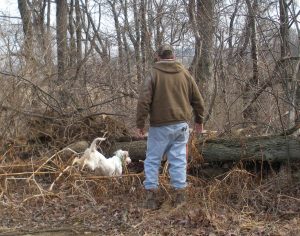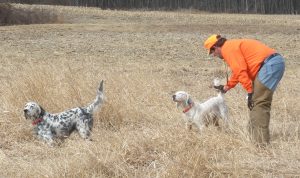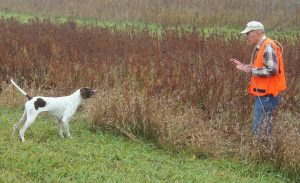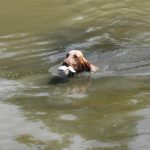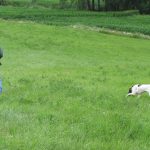Steady or Not?
POINTING DOG POINTERS
By Bob and Jody Iler
Should you steady your pointing dog to wing and shot?
A recent text from Jody’s brother John, who has Finer Points English Setters in Pennsylvania, included photos of his two setters, Jersey and Pearl – mother and daughter, respectively. During a recent workout in the field on quail, John noted that Jersey was “just beautiful . . . dead broke” and “didn’t move a step.” He added that Pearl “has got it – is intense, holding her birds” and “still chasing [at the flush] but now ready for some polishing.”
Training your pointing dog to be steady to wing and shot means that your dog will be rock solid on point as the bird he is pointing is flushed, shot, and falls to the ground. Even then, he will remain steady until given the command to retrieve. Whether to do this training with your dog or not can be a much debated issue. One thing is sure, though. When you see the performance of a dog that has this “polish” – it’s something you won’t forget!
So . . . should you steady your dog?
Maybe you’ve seen a finished dog in action and dream of training your dog to that level someday. Maybe you’d prefer that your dog be hot on the bird right after the flush. Let’s take a look at some of the advantages and disadvantages of this training.
Advantages
- If you hope to participate in field events in addition to hunting with your pointing dog, many events will require your dog to exhibit this higher level of performance. It’s rewarding to work hard with your dog to accomplish these goals and you can take justifiable pride in having a polished dog!
- A dog that is steady to wing and shot has developed the manners to keep him from “emptying” the field ahead and sending the birds flying out of range. He will also stop on a wild flush and he won’t bump other nearby birds that may be sitting tight.
- The dog that is steady is safer from harm. We’ve all seen the dog that nearly takes flight with the bird as it flushes! But the dog that is steady is safe from the too-quick firing of a shotgun. When you are hunting near roads with more traffic, it’s dangerous if your dog gives chase after a flushed bird that flies over that road. The steady dog will remain on point, no matter what direction the bird flies in.
- We’ve found that steadying a dog can sometimes remedy certain problems, such as creeping or jumping in on birds. During the training process, the dog learns that once he points the bird, he must stay on point and not move until he is commanded to do so.
Disadvantages
- Losing birds can be a problem. A crippled pheasant could hit the ground running and may be in the next county by the time you release your dog for the retrieve. Along the same line, a dog may have trouble marking a bird in heavy or difficult cover while he remains steady, sometimes resulting in lost birds that are unable to be found.
- Once a dog is steady to wing and shot, he must always be kept so. This demands work and diligent vigilance on your part. He shouldn’t be run with other dogs that are not steady, nor should he be put in situations that may undo this training.
- Heavy cover that makes it difficult for you to see your dog on point or get to him for the release can sometimes cause your dog to break and get in the habit of flushing birds himself.
- Some dogs can be too soft for this type of training, particularly if it is begun too soon. These dogs may lose their motivation to hunt and this will put you far back in your development program. Other dogs can be hard-headed and difficult to steady to wing and shot, presenting challenges at every turn.
Whether to steady your pointing dog or not really depends on you, your dog, and what you hope to accomplish in your years together. As trainers, we favor the dog that demonstrates that extra polish of being steady to wing and shot, but we realize that all dogs are not candidates for this training, and not all owners want their dogs to be steady.
Back to John – and Jersey and Pearl! John believes that his dogs will show him when the time is right for them to be steadied, and that there is no need to be in a rush. His setters are full of fire – yet soft – and they are smart and eager to please. They need to be brought along at their own pace. This ensures that the advanced training is more natural to the dog that is ready for it, and easier on the trainer, whose job it is to take that intensity to a new level and instill the manners of a top notch pointing dog.
We like to hunt our dogs at least a season before we steady them. Your pointing dog pup needs a couple of years to grow up, and we believe in “letting pups be pups.” With each stage of growth, your pup will learn something new, developing confidence and drive, indicating that he’s ready for the next level of training.
Steadying a dog to wing and shot can take a lot of time and a lot of work. It is an art in the training of class bird dogs, and to us, well worth it.
Pointing Dog Pointers features monthly training tips by Bob and Jody Iler, who own Green Valley Kennels in Dubuque, Iowa. Bob and Jody have trained pointing dogs for over 35 years and have written many articles for The Pointing Dog Journal.



